On this small, windswept island in the North Atlantic, rocky shores and raw weather belie the verdant, misty interior that earned it the famed moniker “the Emerald Isle.” Likewise, the lively, welcoming Irish culture has two sides: modern and forward looking, but simultaneously deeply ingrained with ancient Celtic history, mythical tales and otherworldly peoples.
If a trip to Ireland is calling out to you, this guide will highlight the following:
- Why Visit Ireland?
- The Top Destinations in Ireland
- The Top Outdoor Activities in Ireland
- How to Plan Your Trip
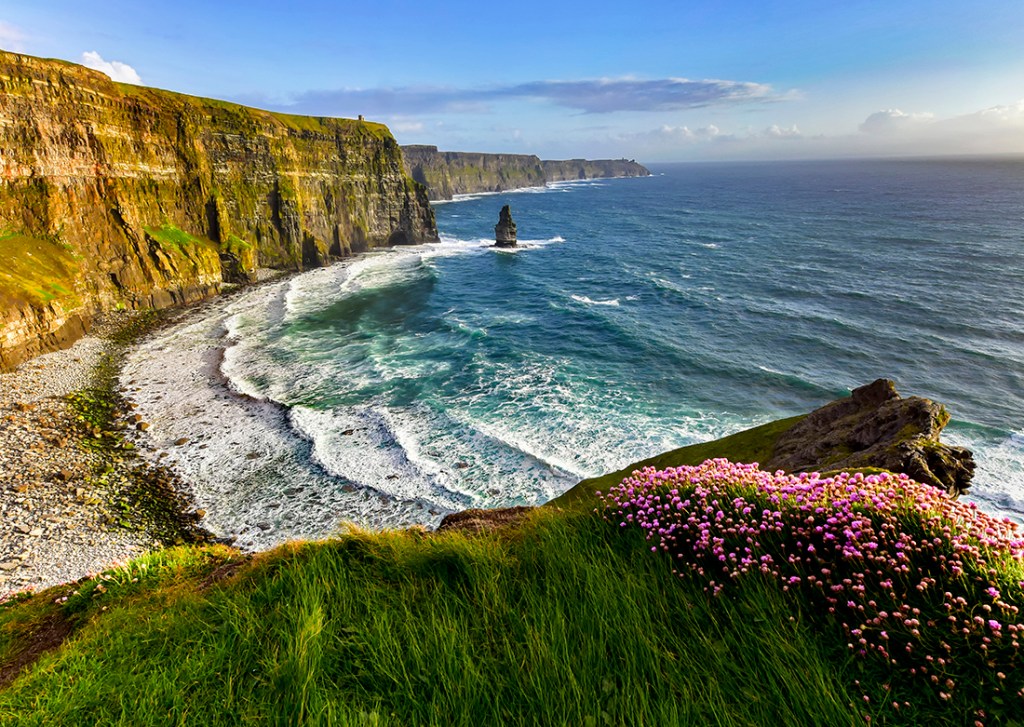
The Cliffs of Moher at sunset, County Clare, Ireland.
Although Irish prowess in music, arts and literature has long been celebrated, it’s only in recent years that Ireland has finally come back into its own. A robust economy has allowed new interests among the Irish, including a new move toward the superb outdoor recreation and adrenaline-driven adventures the landscapes have to offer. All of these factors have conspired to create the perfect amalgamation of opportunity for adventure travelers to enjoy Ireland’s raw, rugged landscapes and unique cultural offerings.
Why Visit Ireland?
The charm of Ireland looms large in Western, and especially American, culture, particularly for a small island with about the same square mileage as West Virginia. The outsize impact can be chalked up to a vivacious and distinct culture taken all over the world during the Irish diaspora, considered one of the most diverse scatterings of any nationality.
Ireland has long been known to have one of the richest, continuously maintained traditions of folklore, myths and history in Europe. Tens of millions of people around the world report some amount of Irish heritage; it’s estimated that since 1700, about 10 million people born in Ireland left the island and took aspects of their culture with them, such as St. Patrick’s Day, Halloween, Irish dance and giants of literature like Yeats, Shaw and Joyce.
So, it’s no surprise that curiosity about an ancestral homeland has long been a huge attraction for many visitors to Ireland. But these days, whether or not you have Irish blood, the welcome is warm and open.
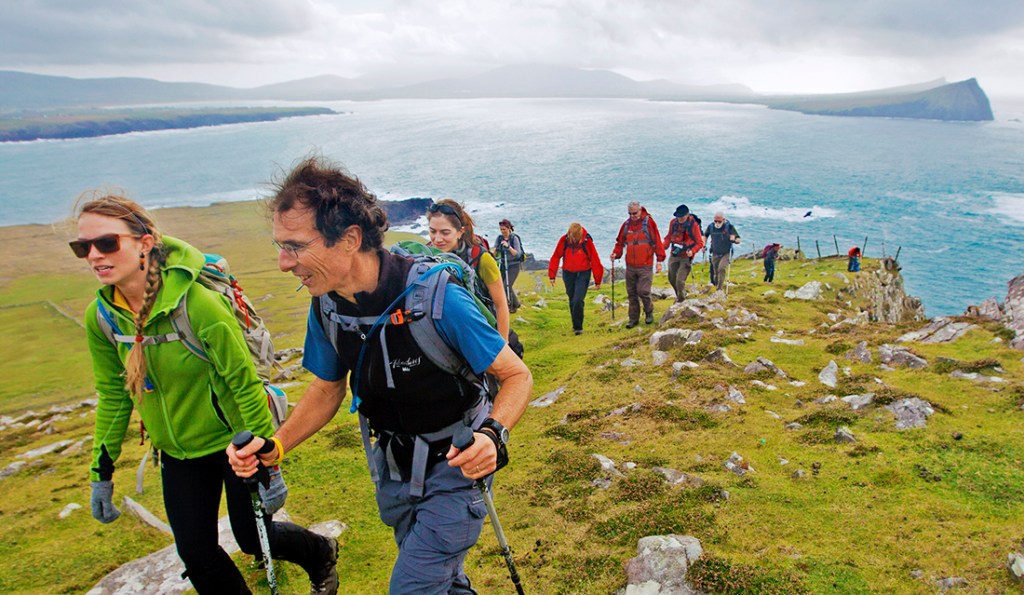
A group treks along the Irish coast.
Adrenaline pursuits aside, it’s not possible to go anywhere or do anything without the Irish love of storytelling adding some color. You’ll find everything on the Emerald Isle is attached to a myth involving ancient deities, saints or fairies, and everything—from open fields, breaking waves, to cottages and castles—is haunted by some tormented soul or had some kind of enchantment cast upon it long ago.
On a less ephemeral note, it’s important to remember that the Irish Republic is the independent, sovereign Irish nation. Northern Ireland consists of six counties the British kept during Ireland’s struggle for independence, and thus remains part of the United Kingdom.
Whatever your reasons for visiting, whether it’s to discover surname origin or some of the best up-and-coming adventure spots, you can’t help but be touched by the warm people, the richness and depth of their culture, and the stunning landscapes.
The Top Destinations in Ireland
Dublin is the capital city of Ireland, the center of business, and the main population center on the island, but it still has the feel of a small and friendly city. Its long history means it has many fascinating urban nooks and crannies, and from neighborhoods of tiny cottages to grand Georgian architecture, modern glass buildings and narrow cobblestone streets, Dublin melds the old and new. A new bike share program and the city’s prolific bike lanes make it easy to get around without a car, and the healthy economy has brought an international flair to the capital.
Dublin
Ireland’s lively capital originated as a Viking settlement around 840 AD, but just upriver was an Irish settlement called Baile Átha Cliath; Irish speakers today call the city Áth Cliath, a name you’ll see on signs all over town. About 1.3 million people live in the Dublin metro area, and while a small city, this urban center of Ireland brims with the arts, literature, music, Irish and international cuisine, famed local libations and nightlife.
Temple Bar
Both an actual bar and a neighborhood, this charming network of narrow cobblestone streets is crowded with historic buildings, shops selling local artisanal wares, galleries and pubs. It’s also famed for rowdy nightlife that lasts deep into the wee hours.

Replicated around the world, Irish pubs are an excellent place to enjoy a drink and some local music.
With towering stone columns, intricate floors and stained glass windows, Saint Patrick’s Cathedral is a Dublin landmark and Ireland’s largest church.
St. Stephen’s Green and Grafton Street
A pedestrian shopping area, Grafton Street is famed for high-end shops, where you can find Irish crafts, jewelry, rare books, cheeses galore and more. If it’s a sunny day, grab some picnic food and keep on going right into St. Stephen’s Green, a cherished garden park in the middle of the city where Dubliners flock during spells of nice weather.
Phoenix Park
Pedal a bike-share up the Liffy’s bike lanes to Phoenix Park (interestingly, the name is not from the mythic bird, but derived from the Irish words, fionn uisce, meaning clear water). The largest enclosed (it has low-walled borders) city park in Europe—and recipient of the International Large Urban Parks Gold Award—it’s twice the size of New York’s Central Park.
Originally a 1600s royal hunting ground, it was opened to the public in 1747, and today is a massive urban oasis of green fields, woods, trails, gardens, bike lanes, a zoo, cricket and polo fields and historical monuments beginning with a 5,500-year-old megalithic tomb. A cherished, protected herd of fallow deer freely roam the park to boot.
Museums
Dublin has its share of excellent museums, a few of which stand out as unique to Dublin. The acclaimed Little Museum of Dublin tells the history of the city; Dublin Writer’s Museum celebrates the rich, internationally renowned Irish literary tradition; and Kilmainham Gaol provides a fascinating look into the darker side of recent Irish history and under British rule.
The Old Library at Trinity College
A visit to the he Old Library is a must in order to see the Book of Kells. This Irish cultural treasure is the world’s most famous illustrated medieval manuscript.
The Irish Countryside
Dublin may be the thriving, newly international and diverse capital, but the real heart and warmth of Ireland is found all through the countryside, from small inland farming towns to coastal villages. Misty, ethereal landscapes and abundant ruins are scattered everywhere on the island, and you can’t go wrong wherever you wander. Here are a few highlights:
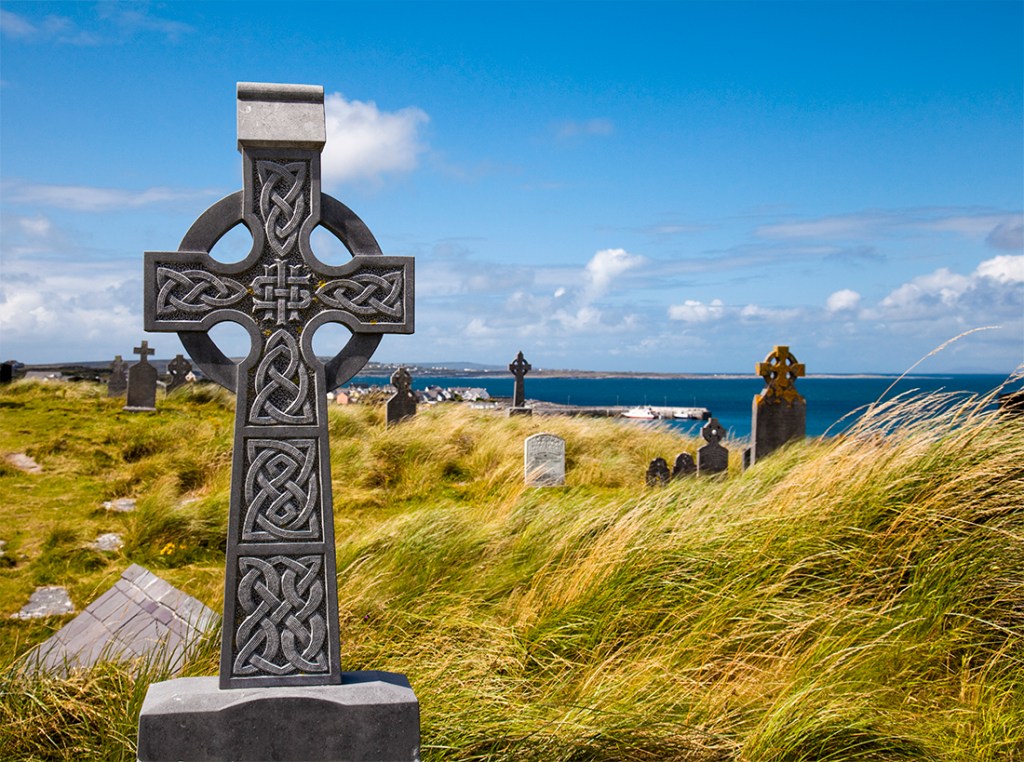
Ruins and centuries-old grave sites are a common sight in Ireland.
Newgrange (UNESCO World Heritage site)
Not far from Dublin and part of the Brú na Bóinne (Boyne Valley tombs), Newgrange is a 5,200-year-old Stone Age passage tomb. Rife with mesmerizing megalithic art and carvings, it was engineered to mark the precise winter solstice, when the sun’s angle aligned directly with the passage precisely at sunrise. A sophisticated example of early astronomy and engineering, Newgrange predates the Great Pyramid at Giza by at least 500 years, and Stonehenge by 1,000.
The Hill of Tara
Thirty minutes from Newgrange is Tara, a ceremonial site for the High Kings of ancient Ireland, as well as the magical Tuatha da Dannan, a mythical fairylike people whose story has passed down for thousands of years in Irish lore. This is an iconic archeological site, and Tara looms very large even in the modern Irish identity for its role in history and central theme in folklore.
You can take the Wicklow Way or a modern road to this famed example of a medieval monastic ruin, including a round tower, which you’ll see in various parts of Ireland. The monks would run up the tower during an invasion, pull up the ladder after themselves, and wait until the invaders went away.
Cashel, County Tipperary
Atop the Rock of Cashel stands a medieval complex dating in part to the 12th century. This very popular tourist destination, while often crowded, is enlightening and worth a visit.
West Coast and Wild Atlantic Way
The counties that make up much of the west coast are steeped in old Irish culture, with Irish language speakers, lively music and pubs, and charming, colorful fishing towns. The rich inland greenery turns abruptly into stunning cliffs, rocky shores, seabirds, marine life and ocean air. Here are a few top spots to check out, but, like all of Ireland, it’s hard to go wrong, regardless of where you end up.
Inishowen, County Donegal
Ireland’s largest and northernmost peninsula is full of wild and unspoiled landscapes, and, due to its northern latitude, is a popular place to try to see the northern lights.
Aran Islands, County Galway
These three islands, Inis Mór, Inishmaan, and Inisheer, just off Galway, are imbued with desolation and beauty and feel like the end of the world. Reachable by ferry or air, the Aran Islands are an ideal place to use a bicycle for sightseeing. You can bring your own or rent on the island, and don’t miss Dun Aonghasa, a Bronze Age Celtic fort on Inis Mór.
Galway, County Galway
The city of Galway is a showcase of the west, with charming, friendly culture, colorful old architecture and incredible, fresh cuisine. Hit up Eyre Square for pubs, music and shops, and the Latin Quarter for sightseeing, which has remnants of medieval city walls.
Skellig Michael, County Kerry
This tiny rocky island is famed for an ascetic colony of 6th-century Gaelic Christian monks who lived a simple, rough life in beehive-shaped stone dwellings. While not always accessible because of the rough seas, sobering, fascinating and intact remnants of the colony survive.
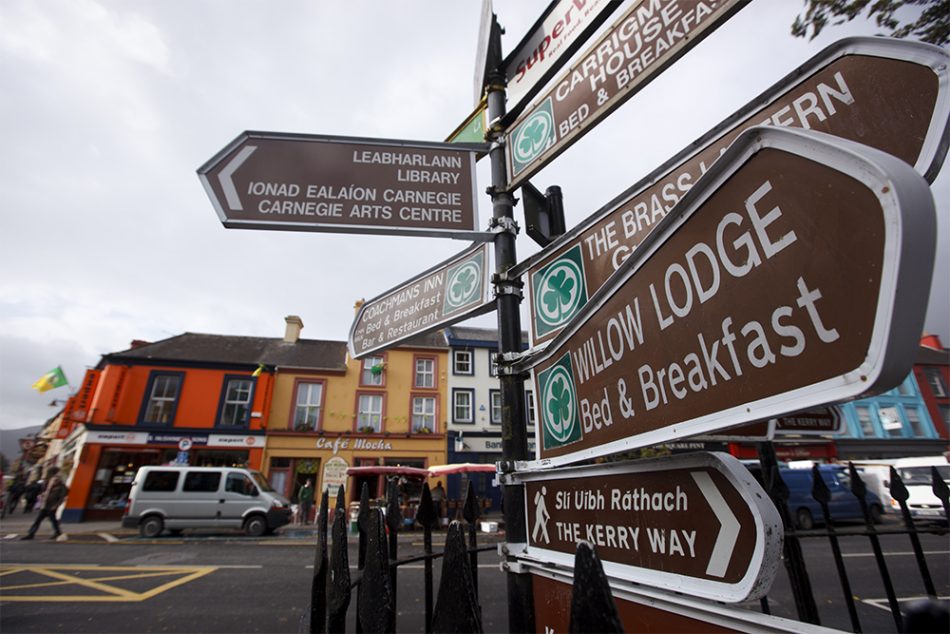
Both modern English and traditional Irish are used for communication throughout the Emerald Isle.
Dingle Peninsula, County Kerry
A rugged, sheep-dotted outcropping framed by beaches and cliffs along the sea and mountains inland, the Dingle Peninsula is a center of Irish language, culture and rural charm. This westernmost finger off the mainland can be toured with a bike or your running shoes, if you follow the 30-mile loop road. You’ll also find hiking paths in the mountains. The natural beauty and scattered ruins thousands of years old will reward your efforts.
The Top Outdoor Activities in Ireland
With nearly 40 percent of Ireland’s approximately five-million residents living in the Dublin metropolitan area, there’s an increasing amount of adventure sports infrastructure and resources in and around the city. But outside of the city, adventures also abound, and it’s super easy to get off the beaten track in rural, uncrowded hinterlands and coastal areas. Surfing, cycling, hiking, rock climbing and trail running are just a few of the activities you’ll find. Below are a few highlights of the many options:
Hiking and Trail Running
Modern trails are often based on traditional walking routes that have historically crisscrossed Ireland. Even in this tiny country, it’s easy to find oneself off the beaten tourist track.
The trails cover an impressive variety of terrain and offer an immersive experience that you can take in at your own speed—whether you’re running or hiking. Most importantly, traveling on foot might just be the best way to take in the landscape, weather and culture, and get a genuine glimpse into Ireland’s beautifully enchanting and haunted heart.
Some popular hiking areas in Ireland include:
The Wicklow Way, Counties Dublin, Wicklow, Carlow
This famed 80-mile trail begins just five miles from Dublin’s bustling city center in Marlay Park and winds up into the nearby Wicklow Mountains (colloquially referred to as the Dublin Mountains). The route originally connected small rural communities and today is a gorgeous, undulating trail through forests, upland bogs, open mountainsides, lakes, waterfalls and working farms. You’ll also pass through small villages and the famed Glendalough’s extensive 6th-century monastic ruins.
Most visitors are unaware that Dublin is a port and a coastal city, but you’ll never forget it if you run or hike the trail loops at Howth, just about five miles from Dublin’s city center on the coast. This urban escape has a cliffside trail network above the Irish Sea and makes for a good introduction to Ireland’s stunning, raw and rugged shores.
The Atlantic coast’s famed Cliffs of Moher showcase western Ireland’s glory, with the landscape falling away in an instant, with miles of massive, sheer cliffs dropping to the ocean. The main trail for hiking or running extends along the clifftop for about 11 miles, including some harrowing sections not for the faint of heart.
End it with a Guinness and fresh seafood in Doolin, a charming seaside village considered the heart of Ireland’s lively traditional music scene. The Cliffs of Moher and the Burren, an adjacent, glacially smoothed landscape of limestone, were designated a UNESCO geopark in 2015, which promotes conservation, environmental education and sustainable tourism practices for visitors.
The first national park in Ireland, Killarney was created in 1932 by the newly formed Irish Free State, and in 1982 was designated a UNESCO biosphere reserve. In Killarney’s 26,000 acres, you can run and hike through forested hills, and past lakes, waterfalls and experience firsthand the native flora and fauna. Though the island’s ecosystem is less biodiverse than much of Europe, the Irish are working to restore and preserve it, including protecting the park’s cherished, sole remaining herd of indigenous red deer, which have inhabited Ireland since Neolithic times.
Road Cycling and Mountain Biking
Cycling in Ireland has long been a part of life, though for many decades it was more utilitarian than for fitness. But over the last few decades a healthy economy has given the Irish more disposable income and free time—and they’ve begun to notice the recreational opportunities around them. Other Europeans moving to Ireland for jobs are bringing their love of both road and mountain biking, so there’s an increasing number of mountain bike trails and road cyclists.
On top of that, in 1993 Dublin launched a campaign to promote biking for fitness and health, and to reduce pollution and congestion on Ireland’s narrow, windy roads. Within in the capital you’ll now find plentiful bike lanes, a city bike share program and a plethora of resources for local and visiting cyclists.
Road Biking
Although the roads are winding and narrow, Irish drivers are for the most part attentive and courteous to bikers. Bikepacking around Ireland is very feasible.
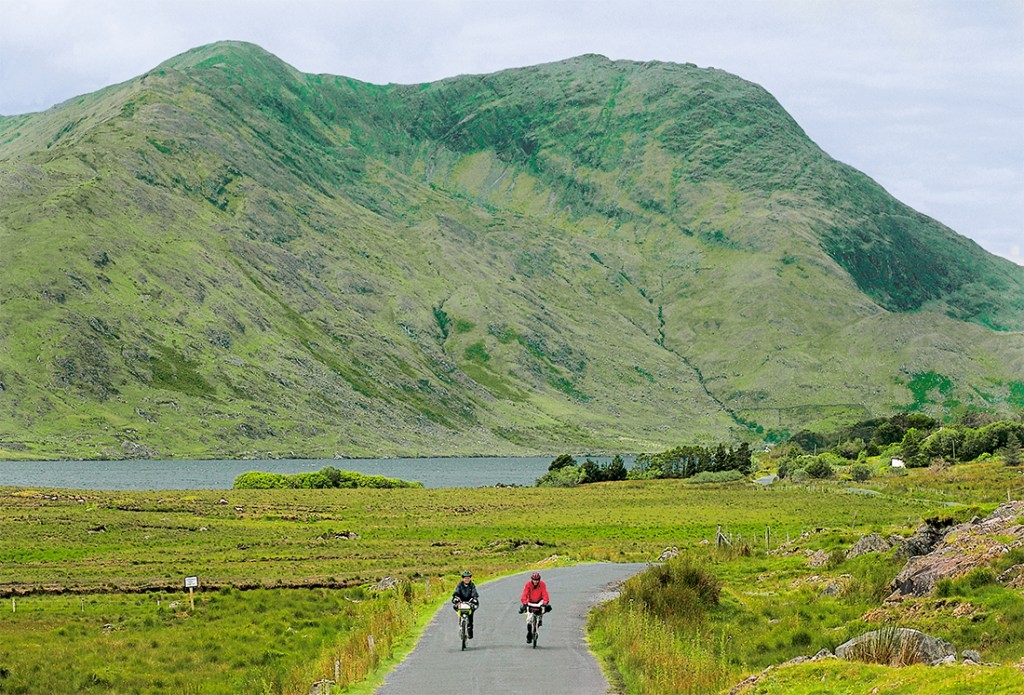
Cyclists navigate the green, pastoral landscape of the Irish countryside.
If you don’t have time to cover the whole country, riding along the Atlantic coast, beginning in County Mayo, down through Achill Island and ending in Galway is a top choice for sights, culture and fresh seafood.
Mountain Biking
Mountain biking is popular in Ireland and the number of trails throughout the country’s rolling mountains is growing. Although there are MTB trails and clubs all over the Emerald Isle, the most popular and developed trails are closer to the populous Dublin metro area.
Less than 30 minutes from Dublin, Ticknock and Ballinastoe are popular trail centers, and Glencullen Adventure Park offers more advanced trails. A fun getaway option is Bike Park Ireland in Tipperary, with varying levels of trails, as well as camping on-site.
Surfing, Kiteboarding, Kayaking and SUP
It’s easy to switch up Ireland’s relentlessly green landscape for some golden sand and deep blue-gray water. The Irish have long been a seafaring people, so it’s not surprising that their country is rapidly becoming an adrenaline watersports mecca. Though the water (and often the air) may be cold, the quality of the winds, waves and paddling is on par with the world’s most-coveted watersports destinations.
Pristine beaches, charming, colorful fishing villages, and at every spot a beautiful on-land backdrop are just the icing on the cake. It’s not a place just for experts—there’s plenty of opportunity for novices to get on the water, take lessons and check out the landscape from offshore.
Surfing
For surfers, the action is on the Atlantic side. From reliable rolling waves on beach breaks to Aileen’s, one of the most sought-after big waves in the world, most of the surf spots offer something for both accomplished surfers and beginners. Beyond the sport, parts of the west are still part of the Gaeltacht, or Irish speaking region, and in these spots the Irish culture is particularly strong.
County Sligo boasts a variety of surf beaches and growing surf culture; a standout beach is Strandhill, for varied levels, while Enniscrone is a great place for beginners. Tullan Strand in Bundoran, County Donegal, offers expert surfing at one end of the beach and gentle waves at the other, and Lahinch Strand in County Clare is considered by many in Ireland to be the epicenter of Irish surf culture.
If Aileen’s is breaking under the Cliffs of Moher, you may catch some pros in action. And know that Aileen’s—as everything in Ireland—is attached to a myth: The ancient Irish called the wave Aill na Searrach, or Foal’s Leap, for the seven Celtic gods who turned themselves into horses and charged through the fearsome wave into the afterlife, livid because Christianity had come to Ireland.
Kiteboarding
Dublin Bay, just minutes by bike or foot from the city center, is a kiter’s dream. Kiting schools have popped up on either side of the port: Poolbeg is the less scenic of the two spots, but has a huge tidal range for flat shallow water. Dollymount Strand (Bull Island) is probably Ireland’s most famous kite surf spot, but as kiting’s popularity grows, it can get crowded, according to locals.
A few hours west from the metro area, the Atlantic coast’s Achill Island in County Mayo is known for stellar kiting, with conditions for all levels.
Kayak and SUP
If adrenaline isn’t your cup of tea, paddle a SUP right up the center of Dublin on the storied, tidal River Liffey, which flows from high in the Wicklow Mountains through the center of the city and into the Irish Sea.
A lesser known but wonderful, adventurous way to see the countryside is to canoe or kayak the inland waterways, a system of canals that are vastly more serene than the Irish coast. Referred to now as paddling trails, they are in the process of being turned from disused barge transport routes to a national recreational treasure called Waterways Ireland. Many of them, such as the Royal Canal, take paddlers right out of the major cities and through the countryside into landscapes you won’t see otherwise.
How to Plan Your Trip
Best Time to Visit
Overall, Ireland has a mild maritime climate and doesn’t get too hot or too cold. Snow is rare, as are long stretches of sunshine and dry weather: Ireland’s verdant landscapes come at the price of frequent misting rain and fog.
June, July and August are on average the sunniest and warmest months, but summer is also high season for tourism, making it more crowded and more costly. The better time to visit is April and May or September and October, which may be sunny too.
You may get a mix of weather, but it isn’t all bad—mist, rain and clouds are a huge part of the place and the culture. No matter the weather, if you’re out in the countryside during the gloaming, you may find yourself gaining an inexplicable belief in Ireland’s rich folklore and a true understanding of why nearly every tree, lane and stone has a story of enchantment.
In winter, Ireland is stark, raw and beautiful—but also dark, as the days are short due to the northern latitude (53’ N, parallel to Alaska’s southern Aleutian Islands), and some tourism operations may not be open. Dublin, however, lights up, especially around the holidays.
Ireland is part of the European Union, and uses the euro as currency.
What to Pack
Pack for rain, wind and changing weather, no matter your plans or what sport you may do. If you plan to bike, hike or run long distances, you might want to bring a raincover for your pack or saddlebags. Light layers will be helpful at any time of year, especially for running, cycling or simply hiking the coastal areas. A buff for your ears or face and light gloves would be good to toss in your pack as well.
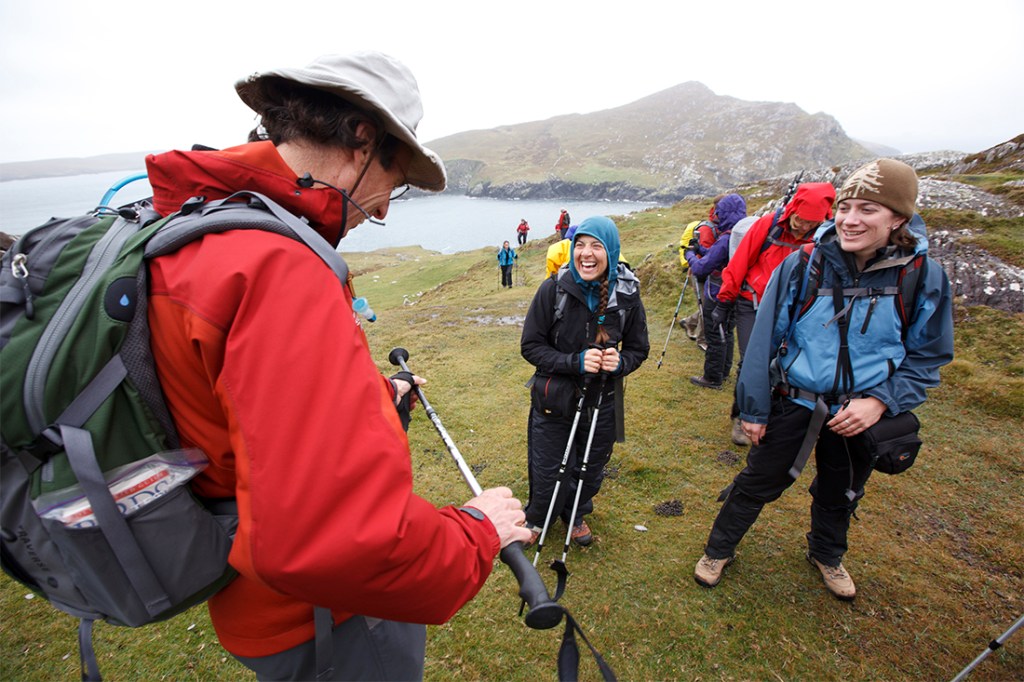
Ireland is often misty and wet, so when tackling outdoor pursuits, be sure to pack for the weather.
If you plan to do water sports, you’ll need a wetsuit—even in the summer, a thickness of 3mm is recommended. The rest of the year, a minimum of 5mm to 6mm and up is recommended. A hood, booties and gloves are useful most of the year as well. Rentals are fairly easy to find, either in Dublin or the surf towns on the west coast.
The Irish practically own the wool sweater, and you’ll quickly figure out why. Bring your own, or even buy one with traditional fisherman patterns.
Finally, if you want to go out on the town, especially in Dublin, it’s worth packing a nice urban evening outfit. The Irish, like many Europeans, are a bit less casual than Americans in social settings and like to dress well.
What to Eat and Drink
Irish cuisine is marked by simplicity, fresh ingredients and hearty preparations. Indulge in staples such as fresh shellfish, fresh or smoked salmon, or Irish salmon gravlax. Cabbage, potatoes and meat make up much of the rest of traditional fare, so try a colcannon (cabbage) or mutton stew.
If you can get your hands on fresh homemade Irish soda bread or traditional brown bread (two very different breads), enjoy either with butter, jam and a cup of tea.
Whiskey: The word whiskey itself comes from the Irish word uisce, or water. There are a few dozen distilleries in Ireland at the moment, and demand continues to grow. The Jameson Distillery is in Dublin, and other notables you might want to try are Midleton, Tullamore DEW and Glendalough.
Beer: Drink the beer. At the very least, have one Guinness stout at a pub.
Cider: Alcoholic cider is very popular in Ireland. It’s often not the sweet kind, but rather, dry, craft ciders from small operations.
Where to Stay
Ireland welcomes visitors wholeheartedly and offers all kinds of accommodations. Choose from historic hotels (some that were once castles), charming bed and breakfasts, and a range of hostels and campgrounds (yes, there’s even glamping).
There is very little public land in Europe in general and Irish land-use issues can be tricky, so check with local authorities if you wish to camp somewhere. Get permission or a permit where necessary and prioritize Leave No Trace ethics.
Key Phrases
While Irish Gaelic is the native and official national language, speaking it was discouraged under centuries of English rule; thus English is the modern lingua franca. All signs are in Irish and English, and only about 39 percent of the population considers itself able to speak Irish, or Geailge. In the Gaeltacht, or certain areas on the west coast, Irish is the predominant language.
The government today promotes Irish, and a couple of fun key phrases to know if you find yourself in a native speaking town are as follows:
Sláinte (slawn-shuh): health/cheers!
Fáilte (fawl-shuh): welcome
Go raibh maith agat (guh ruh mah a gut): thank you!
Dia Duit (gia ditch): hello!
Slán go Foíll (slawn–go-foh-ill): goodbye!
